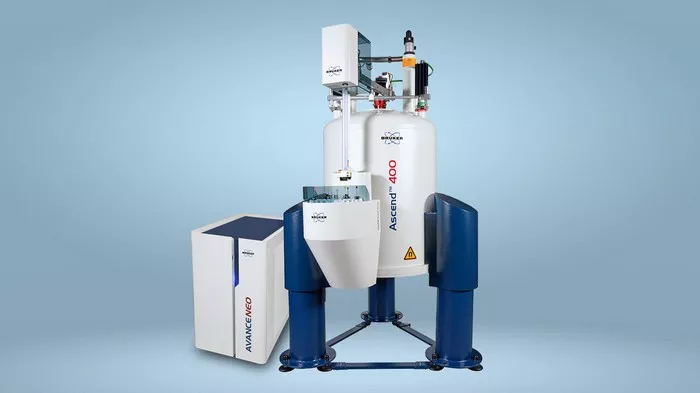At the Joint ENC-ISMAR Conference 2025, Bruker Corporation, a leader in Nuclear Magnetic Resonance (NMR) spectroscopy solutions, made a groundbreaking announcement: the development and successful testing of the world’s first high-resolution 1.3 GHz NMR spectrometer, featuring a stable, standard-bore 54 mm superconducting magnet. This innovative spectrometer is poised to redefine the possibilities in ultra-high field NMR, offering unmatched resolution and sensitivity.
Pioneering Technology: The 1.3 GHz Spectrometer
Building on the success of its 1.0-1.2 GHz systems, Bruker’s new 1.3 GHz NMR spectrometer delivers unprecedented resolution and sensitivity for scientific research. The spectrometer’s core innovation lies in its superconducting magnet, which has a field strength of 30.5 Tesla (T) and integrates a ReBCO high-temperature superconductor (HTS) insert. This advanced magnet architecture allows for even higher magnetic fields, pushing the boundaries of NMR capabilities.
Bruker’s LTS-HTS hybrid magnet architecture extends into this new 1.3 GHz system, preserving the physical dimensions and cryogen consumption similar to Bruker’s existing 1.2 GHz magnets, while only slightly increasing the stray field radius.
Advanced Probe Configurations for Precise Testing
During testing, Bruker employed five distinct NMR probe configurations to examine the spectrometer’s capabilities at a 1.3 GHz proton frequency. These included:
- 3 mm TXI liquids room-temperature probe
- 5 mm TXO liquids CryoProbe
- 111 kHz (0.7 mm) HCN solid-state magic-angle spinning (MAS) probe
- 42 kHz (1.9 mm) solid-state MAS probe for materials research
- 160 kHz (0.4 mm) HCN solid-state MAS probe for biological systems
The tests confirmed the spectrometer’s ability to generate high-resolution liquids and solids NMR spectra, demonstrating enhanced resolution and sensitivity. These results suggest that the 1.3 GHz system could play a key role in biomolecular and materials research, enabling more detailed studies of complex systems.
Impact on Biomolecular and Materials Research
One of the most significant advancements of the 1.3 GHz system is its ability to enhance the study of bio-macromolecules that often lack dispersion, such as carbohydrates, glycoproteins, RNA, and intrinsically disordered proteins (IDPs). The increased sensitivity at 1.3 GHz, particularly in 13C and 15N direct detection of IDPs, provides new opportunities to explore atomic resolution, dynamics, and function within these systems.
The solid-state NMR community will also benefit from these advancements. Higher field strengths allow for narrower spectral lines in studies of quadrupolar nuclei, thanks to the inverse relationship between the breadth of the quadrupolar pattern and the field strength. Additionally, the chemical shift interaction grows linearly with field strength, improving the ability to measure chemical shift tensors—a crucial development for both material and biological sciences.
Statements from Experts
Dr. Falko Busse, President of the Bruker BioSpin Group, expressed excitement about the new capabilities: “Achieving 1.3 GHz is yet another testament to Bruker’s commitment to innovation. We are confident that our high-resolution GHz-class NMRs will enable researchers to advance their scientific understanding of complex biomolecular systems, while also benefiting advanced materials science research, particularly in molecules and materials incorporating chemical elements with quadrupolar and low-gamma nuclei.”
Dr. Takanori Kigawa, a leading researcher in structural biology at the Center for Integrative Medical Sciences at RIKEN Yokohama Institute, Japan, shared his enthusiasm: “We are thrilled to be among the first scientists to experiment with the 1.3 GHz NMR spectrometer. The increase in resolution and sensitivity is remarkable, and we are excited about the new possibilities for our research on protein and nucleic acid samples.”
Dr. Pierre Florian, a materials science researcher at CEMHTI-CNRS Orléans, France, who conducted solid-state samples characterization, added: “The 1.3 GHz spectrometer has dramatically improved our ability to resolve different types of atomic environments in complex materials. The sensitivity and resolution are unprecedented.”
A New Era for NMR Research
With its cutting-edge 1.3 GHz NMR spectrometer, Bruker has ushered in a new era for ultra-high-field NMR. The system’s enhanced resolution, sensitivity, and magnetic field strength open new frontiers for studying complex biomolecular systems and advanced materials. The introduction of the 1.3 GHz system signals a significant leap forward in the realm of scientific discovery, particularly in biomolecular and materials research, offering an exciting glimpse into the future of NMR spectroscopy.
Related topics:

